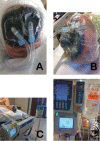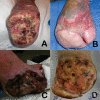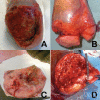Wound chemotherapy by the use of negative pressure wound therapy and infusion
- PMID: 20090841
- PMCID: PMC2806786
Wound chemotherapy by the use of negative pressure wound therapy and infusion
Abstract
Introduction: Although the use of negative pressure wound therapy (NPWT) is broadly efficacious, it may foster some potentially adverse complications. This is particularly true in patients with diabetes who have a wound colonized with aerobic organisms. Traditional antiseptics have been proven useful to combat such bacteria but require removal of some NPWT devices to be effective.
Methods: In this article, we describe a method of "wound chemotherapy" by combining NPWT and a continuous infusion of Dakins' 0.5% solution either as a standardized technique in one device (ITI Sved) or as a modification of standard technique in another (KCI VAC) NPWT device. The twin goals of both techniques are to effectively reduce bacterial burden and to promote progressive wound healing.
Results: We present several representative case examples of our provisional experience with continuous streaming therapy through 2 foam-based negative pressure devices.
Discussion: Wound chemotherapy was successfully applied to patients with diabetes, without adverse reactions, complications, or recolonization during the course of treatment. We believe this to be a promising method to derive the benefits of NPWT without the frequent adverse sequela of wound colonization.
Figures




Similar articles
-
EWMA Document: Negative Pressure Wound Therapy.J Wound Care. 2017 Mar 1;26(Sup3):S1-S154. doi: 10.12968/jowc.2017.26.Sup3.S1. J Wound Care. 2017. PMID: 28345371 Review.
-
Novel negative pressure wound therapy device without foam or gauze is effective at -50 mmHg.Wound Repair Regen. 2019 Mar;27(2):162-169. doi: 10.1111/wrr.3. Epub 2018 Oct 31. Wound Repair Regen. 2019. PMID: 30378215
-
A novel option in negative pressure wound therapy (NPWT) for chronic and acute wound care.Burns. 2012 Jun;38(4):573-7. doi: 10.1016/j.burns.2011.10.010. Epub 2011 Nov 17. Burns. 2012. PMID: 22100423 Clinical Trial.
-
Cost-effectiveness of negative pressure wound therapy for postsurgical patients in long-term acute care.Adv Skin Wound Care. 2009 Mar;22(3):122-7. doi: 10.1097/01.ASW.0000305452.79434.d9. Adv Skin Wound Care. 2009. PMID: 19247013
-
An overview of negative pressure wound therapy (NPWT).Br J Community Nurs. 2008 Jun;13(6):S23-4, S26, S28-30. doi: 10.12968/bjcn.2008.13.Sup3.29469. Br J Community Nurs. 2008. PMID: 18773763 Review.
Cited by
-
The efficacy and safety of negative pressure wound therapy in paediatric burns: a systematic review and meta-analysis of randomized controlled trials.BMC Pediatr. 2024 Dec 18;24(1):807. doi: 10.1186/s12887-024-05302-z. BMC Pediatr. 2024. PMID: 39696096 Free PMC article.
-
The micrograft concept for wound healing: strategies and applications.J Diabetes Sci Technol. 2010 Jul 1;4(4):808-19. doi: 10.1177/193229681000400407. J Diabetes Sci Technol. 2010. PMID: 20663442 Free PMC article. Review.
-
Management of negative pressure wound therapy in the treatment of diabetic foot ulcers.World J Orthop. 2015 May 18;6(4):387-93. doi: 10.5312/wjo.v6.i4.387. eCollection 2015 May 18. World J Orthop. 2015. PMID: 25992316 Free PMC article. Review.
-
Novel use of insulin in continuous-instillation negative pressure wound therapy as "wound chemotherapy".J Diabetes Sci Technol. 2010 Jul 1;4(4):820-4. doi: 10.1177/193229681000400408. J Diabetes Sci Technol. 2010. PMID: 20663443 Free PMC article. Review.
-
Use of negative pressure wound therapy with automated, volumetric instillation for the treatment of extremity and trunk wounds: clinical outcomes and potential cost-effectiveness.Eplasty. 2014 Nov 3;14:e41. eCollection 2014. Eplasty. 2014. PMID: 25525480 Free PMC article.
References
-
- Armstrong DG, Attinger CE, Boulton AJ, et al. Guidelines regarding negative wound therapy (NPWT) in the diabetic foot. Ostomy Wound Manage. 2004;50(4B suppl):3S–27S. - PubMed
-
- Armstrong DG, Lavery LA. Negative pressure wound therapy after partial diabetic foot amputation: a multicentre, randomised controlled trial. Lancet. 2005;366(9498):1704–10. - PubMed
-
- Vikatmaa P, Juutilainen V, Kuukasjarvi P, Malmivaara A. Negative pressure wound therapy: a systematic review on effectiveness and safety. Eur J Vasc Endovasc Surg. 2008;36(4):438–48. - PubMed
-
- Payne JL, Ambrosio AM. Evaluation of an antimicrobial silver foam dressing for use with V.A.C. therapy: morphological, mechanical, and antimicrobial properties. J Biomed Mater Res B Appl Biomater. 2009;89(1):217–22. - PubMed
LinkOut - more resources
Full Text Sources
Other Literature Sources
